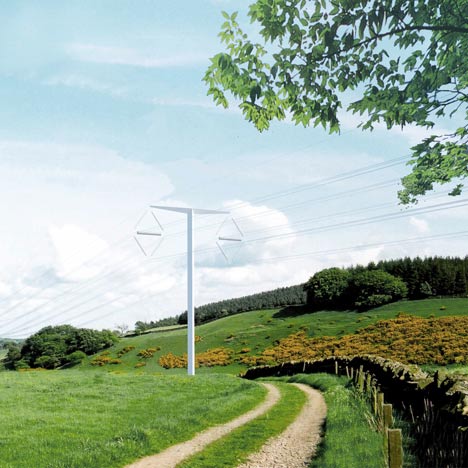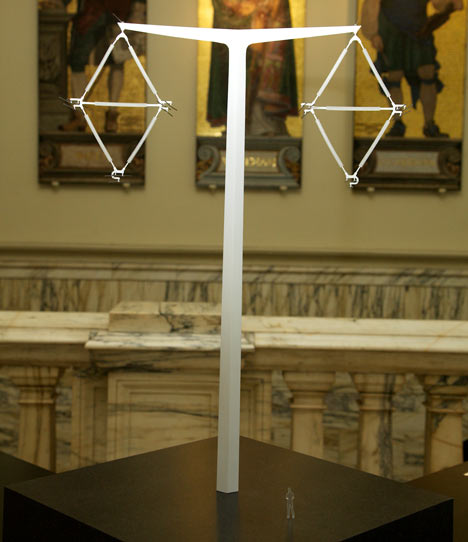
Bystrup win Pylon for the Future competition
Dezeen Wire: Copenhagen studio Bystrup have won the RIBA competition to design new electricity pylons for the UK with their T-shaped proposals.

The T-Pylon design has triangular conductors that hang symmetrically from each side of the structure.
The Pylon for the Future competition was organised in collaboration with the Department of Energy and Climate Change and the National Grid. Dezeen revealed the shortlisted entries for the competition last month – see our earlier story.
Photography is by Zoe Norfolk.
Here's some more information from the DECC:
Winner Of The Pylon Design Competition Announced
Bystrup’s innovative T-Pylon design has been unanimously agreed by the judging panel as the winner of the Pylon Design Competition run by the Department of Energy & Climate Change, National Grid, and the Royal Institute of British Architects.
Following a very high-quality field with 250 entries and six excellent finalists, which were featured at the London Design Festival, the judges were overwhelmed by the huge public interest in the competition.
As a result of this contest National Grid will now work with Bystrup to develop their T-Pylon design further. National Grid has also said it wants to do further work with Ian Ritchie Associates on their Silhouette design, and New Town Studio’s Totem design.
The winner will receive £5000 prize money and the five other finalists will each receive £1000.
Energy and Climate Change Secretary Chris Huhne said:
“This is an innovative design which is simple, classical and practical. Its ingenious structure also means that it will be much shorter and smaller than existing pylons and therefore less intrusive.
“This competition has been a great success in bringing forward new and creative approaches to a pylon model which has not changed since the 1920s. We are going to need a lot more pylons over the next few years to connect new energy to our homes and businesses, and it is important that we do this is in the most beautiful way possible.”
Nick Winser, executive director, National Grid, said:
“In the T-Pylon we have a design that has the potential to be a real improvement on the steel lattice tower. It’s shorter, lighter and the simplicity of the design means it would fit into the landscape more easily. In addition, the design of the electrical components is genuinely innovative and exciting.
“However, the Totem and Silhouette designs are worthy of further consideration – both of them have strong visual appeal and characteristics that could work well in different landscapes.
“We are genuinely delighted at the prospect of working with all three companies to develop some real options for the future."
Ruth Reed, RIBA Immediate Past President, said:
“The potential to reduce the size and height of pylons and consequently their impact on the landscape and the amount of materials in their construction, made this scheme a clear winner for me. The radical design of a single suspension arm carrying three conductors is simple and understated. Whilst there should still be the opportunity for statement designs where they are appropriate, this radical solution is a quantum leap forward for the design of the thousands of pylons needed in the years to come.”
The judging panel was made up of:
Chris Huhne – Secretary of State for Energy & Climate Change
Nicholas Winser – executive director of National Grid
Sir Mark Jones – master of St Cross College Oxford and former director of the V&A
Sir Nicholas Grimshaw – architect
Bill Taylor – architect
Chris Wise – engineer
Jonathan Glancey – journalist
Andrew Grant – landscape architect
Jim Sutherland from Scottish Power
Ruth Reed – former president of RIBA